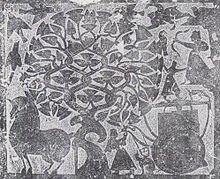


Xihe (Chinese: 羲和; pinyin: Xīhé; Wade–Giles: Hsi-ho), was a solar deityinChinese mythology. One of the two wives of Di Jun (along with Changxi), she was the mother of ten suns in the form of three-legged crows residing in a mulberry tree, the Fusang, in the East Sea. Each day, one of the sun birds would be rostered to travel around the world on a carriage driven by Xihe.
Folklore also held that once, all ten sun birds came out on the same day, causing the world to burn; Houyi saved the day by shooting down all but one of the sun birds.

In the poem Suffering from the Shortness of Days (苦晝短), Li He of the Tang dynasty is hostile and even deviant towards the legendary dragons that drew the sun chariot as a vehicle for the passage of time.[1] The following is the relevant excerpt of that poem:

In the Huainanzi, the journey of the sun and the attendant of the sun chariot is described: